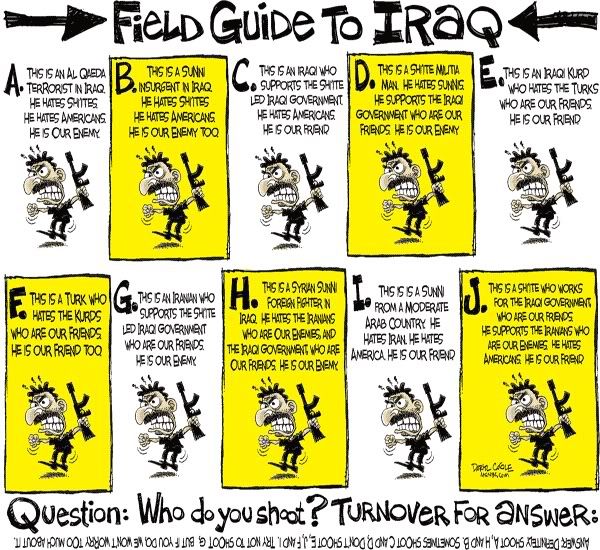The current anti-insurgency approach does not appear to be working. To date, it has centred on three core pillars: the enemy’s destruction (elimination of the largest possible number of fighters), decapitation (suppression of insurgent leaders and leadership structures) and dislocation (recovery of their sanctuaries and disruption of their lines of communication). Yet the armed opposition has been able to replenish its ranks and mobilise necessary (albeit limited) popular support. Even Tandhim al-Qa’ida, a prime target for both coalition and Iraqi security forces, has not displayed any sign of exhaustion.
The insurgency is built around a loose and flexible network, feeds on deep-seated family, tribal and local loyalties, with allegiance to a cause rather than to specific individuals. Insurgent leaders are an important part, but there is no evidence their individual roles are crucial; those who have been killed or captured have been swiftly replaced with no notable impact on any group’s
performance. The insurgents, meanwhile, have been both playing on and exacerbating Sunni Arab hostility, first toward the occupation, and now also toward sectarian Shiite parties seen as intent on taking over national institutions and resources, waging a dirty communal war and pursuing an essentially Iranian agenda. The combination of social networks, an ample supply of weapons, a powerful message and adequate funds has allowed the insurgency to maintain a relatively constant level of violence.
The armed opposition also has found ways around the coalition’s attempt to dislocate it by regaining territory (e.g., Tall ‘Afar and al-Qa’im) or disrupting internet sites. On the ground, the insurgency is responding to the U.S. strategy – “clear, hold, and build” – by one of its own: recoil, redeploy and spoil. Rather than confront the enemy head on, it is taking advantage of its military flexibility, the limited number of U.S. troops and the fragility of Iraqi security forces to attack at the time and place of its maintaining internet communications despite coalition efforts to interrupt them.
The content and evolution of the armed opposition’s discourse carries important lessons in this respect. Over time, the insurgency appears to have become more united, confident, sensitive to its constituents’ demands, and adept at learning from the enemy’s successes and failures and its own. The trend remains fragile – the surface homogeneity in all likelihood conceals deep-seated tensions; the confidence may be short-lived; and the sensitivity has its limitations. But the U.S. needs to take these into account if it is to understand the insurgency’s remarkable resilience and learn how to counter it.
A central message is that the coalition’s most effective tools have not been of a military but rather of a political nature. Televised confessions of insurgent combatants and accusations of sectarianism, brutality and depravity, as well as the various 2005 polls all had a visible impact on the armed opposition, bringing about tangible changes in its behaviour and rhetoric. This was only a start, but it suggests something more profound: the importance to the insurgency of its legitimacy, which essentially relies on opposition to the occupation, anger at its specific practices and the feeling shared by Sunni Arabs of being under siege.
Conducting an effective counter-insurgency campaign requires emphasising this political dimension, taking the armed opposition’s discourse seriously, and directing one’s efforts at the sources of its popular support. Excessive use of force by coalition troops, torture, resort to tactics that inflict widespread harm on civilians and reliance on sectarian militias simultaneously undermine U.S. legitimacy and boost the insurgents’ own, thereby clearly outweighing any possible military gain.
For the U.S. and its Iraqi allies to prevail on this battlefront, they first of all must establish a monopoly over the legitimate use of violence – which means establishing the legitimacy both of the means being deployed and of the state on whose behalf violence is being exercised. That, to date, has been far from the case. Instead, the insurgency flourishes on widespread Sunni Arab perception of U.S. and official Iraqi arbitrariness and coercion. As a result, the U.S. runs the risk of seeing the armed opposition durably entrenched in predominantly Sunni Arab areas which, in a vicious cycle, the central government can reach only through periodic assaults and repressive actions.
A first imperative, of course, is to reach out to the Sunni Arab community, amend the constitution and build a more inclusive polity.206 But that aside, important steps must be taken to alter radically how the counter-insurgency campaign is being waged. For the U.S. and its Iraqi allies, this entails:
�� closely monitoring, controlling and, if necessary, punishing, the behaviour of security forces;
�� halting recourse to the most questionable types of practices, including torture and extraordinary methods of interrogation and confinement, collective punishment and extra-judicial killings;
�� ending the use of sectarian militias as a complement to, or substitute for, regular armed forces and beginning a serious process of disarmament, demobilisation and reintegration (DDR) of militia fighters;
�� the U.S. holding the new government accountable and making clear that longer-term relations, economic assistance and future military cooperation will depend on the steps it takes to rein in and ultimately disband militias, halt politically-motivated killings and respect human rights and the rule of law;
�� the U.S. making clear its willingness, while it remains in Iraq, to negotiate openly the terms of its presence and its rules of engagement;
�� the U.S. making repeatedly clear at the highest level that it accepts that the oil resources of the country belong to the Iraqi people and no one else, and that it will withdraw as soon as the newly elected government so requests.







Bookmarks